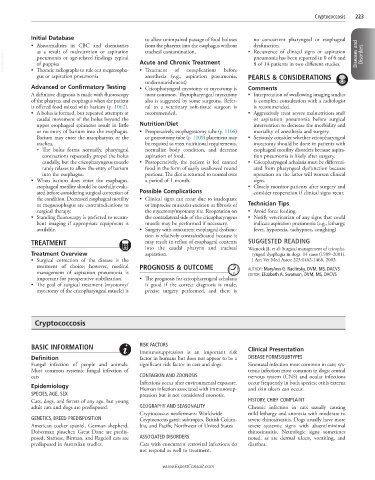Page 496 - Cote clinical veterinary advisor dogs and cats 4th
P. 496
Cryptococcosis 223
Initial Database to allow unimpaired passage of food boluses no concurrent pharyngeal or esophageal
dysfunction.
• Abnormalities in CBC and chemistries from the pharynx into the esophagus without • Recurrence of clinical signs or aspiration
VetBooks.ir pneumonia or age-related findings typical Acute and Chronic Treatment pneumonia has been reported in 0 of 6 and Diseases and Disorders
tracheal contamination.
as a result of malnutrition or aspiration
8 of 14 patients in two different studies.
of puppies
• Thoracic radiographs to rule out megaesopha-
anesthesia (e.g., aspiration pneumonia,
gus or aspiration pneumonia • Treatment of complications before PEARLS & CONSIDERATIONS
undernourishment)
Advanced or Confirmatory Testing • Cricopharyngeal myotomy or myectomy is Comments
A definitive diagnosis is made with fluoroscopy most common. Thyropharyngeal myectomy • Interpretation of swallowing imaging studies
of the pharynx and esophagus when the patient also is suggested by some surgeons. Refer- is complex; consultation with a radiologist
is offered food mixed with barium (p. 1062). ral to a veterinary soft-tissue surgeon is is recommended.
• A bolus is formed, but repeated attempts at recommended. • Aggressively treat severe malnutrition and/
caudal movement of the bolus beyond the or aspiration pneumonia before surgical
upper esophageal sphincter result in little Nutrition/Diet intervention to decrease the morbidity and
or no entry of barium into the esophagus. • Preoperatively, esophagostomy tube (p. 1106) mortality of anesthesia and surgery.
Barium may enter the nasopharynx or the or gastrostomy tube (p. 1109) placement may • Seriously consider whether cricopharyngeal
trachea. be required to meet nutritional requirements, myectomy should be done in patients with
○ The bolus forms normally, pharyngeal normalize body condition, and decrease esophageal motility disorders because aspira-
contractions repeatedly propel the bolus aspiration of food. tion pneumonia is likely after surgery.
caudally, but the cricopharyngeus muscle • Postoperatively, the patient is fed canned • Cricopharyngeal achalasia must be differenti-
rarely relaxes to allow the entry of barium food in the form of easily swallowed round ated from pharyngeal dysfunction because
into the esophagus. portions. The diet is returned to normal over operation on the latter will worsen clinical
• When barium does enter the esophagus, a period of 1 month. signs.
esophageal motility should be carefully evalu- • Closely monitor patients after surgery and
ated before considering surgical correction of Possible Complications consider reoperation if clinical signs recur.
the condition. Decreased esophageal motility • Clinical signs can recur due to inadequate
or megaesophagus are contraindications to or imprecise muscular excision or fibrosis of Technician Tips
surgical therapy. the myectomy/myotomy site. Reoperation on • Avoid force feeding.
• Standing fluoroscopy is preferred to recum- the contralateral side of the cricopharyngeus • Notify veterinarian of any signs that could
bent imaging if appropriate equipment is muscle may be performed if necessary. indicate aspiration pneumonia (e.g., lethargy,
available. • Surgery with concurrent esophageal dysfunc- fever, hyporexia, tachypnea, coughing)
tion is relatively contraindicated because it
TREATMENT may result in reflux of esophageal contents SUGGESTED READING
into the caudal pharynx and tracheal Warnock JJ, et al: Surgical management of cricopha-
Treatment Overview aspiration. ryngeal dysphagia in dogs: 14 cases (1989–2001).
• Surgical correction of the disease is the J Am Vet Med Assoc 223:1462-1468, 2003.
treatment of choice; however, medical PROGNOSIS & OUTCOME AUTHOR: MaryAnn G. Radlinsky, DVM, MS, DACVS
management of aspiration pneumonia is EDITOR: Elizabeth A. Swanson, DVM, MS, DACVS
important for preoperative stabilization. • The prognosis for cricopharyngeal achalasia
• The goal of surgical treatment (myotomy/ is good if the correct diagnosis is made,
myectomy of the cricopharyngeal muscle) is precise surgery performed, and there is
Cryptococcosis
BASIC INFORMATION RISK FACTORS Clinical Presentation
Immunosuppression is an important risk
Definition factor in humans but does not appear to be a DISEASE FORMS/SUBTYPES
Fungal infection of people and animals. significant risk factor in cats and dogs. Sinonasal infection most common in cats; sys-
Most common systemic fungal infection of temic infection most common in dogs; central
cats CONTAGION AND ZOONOSIS nervous system (CNS) and ocular infections
Infections occur after environmental exposure. occur frequently in both species; otitis externa
Epidemiology Human infection associated with immunosup- and skin ulcers can occur.
SPECIES, AGE, SEX pression but is not considered zoonotic.
Cats, dogs, and ferrets of any age, but young HISTORY, CHIEF COMPLAINT
adult cats and dogs are predisposed. GEOGRAPHY AND SEASONALITY Chronic infection in cats usually causing
Cryptococcus neoformans: Worldwide mild lethargy and anorexia with moderate to
GENETICS, BREED PREDISPOSITION Cryptococcus gattii: subtropics, British Colum- severe rhinosinusitis. Dogs usually have more
American cocker spaniel, German shepherd, bia, and Pacific Northwest of United States severe systemic signs with absent/minimal
Doberman pinscher, Great Dane are predis- rhinosinusitis. Neurologic signs sometimes
posed; Siamese, Birman, and Ragdoll cats are ASSOCIATED DISORDERS noted, as are dermal ulcers, vomiting, and
predisposed in Australian studies. Cats with concurrent retroviral infections do diarrhea.
not respond as well to treatment.
www.ExpertConsult.com

